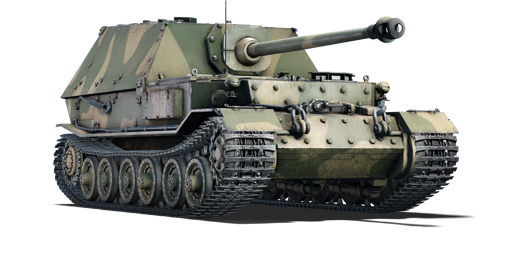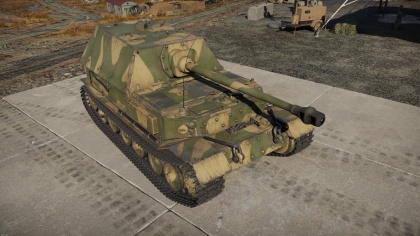Difference between revisions of "Ferdinand"
(→History) (Tag: Visual edit) |
(→Usage in battles) (Tag: Visual edit) |
||
| Line 27: | Line 27: | ||
== Usage in battles == | == Usage in battles == | ||
| − | ' | + | |
| + | The Ferdinand is a heavy tank abut can go backwards quickly, which allows it to reposition more quickly than Red Army TD's like the SU-152 and ISU-152. | ||
| + | |||
| + | Its natural role is as a long-range sniper. Thanks to its excellent firing range and frontal armour of more than 200mm, it should always face the enemy. | ||
| + | |||
| + | In a team the Ferdinand acts as a heavy sniper, taking out enemies from afar while being almost immune to any tank shells. However don't get too close to ffront-lines, since an enemy tank could slip behind you and the Ferdinand would be in real danger. | ||
| + | |||
| + | Another possibility is as a front line brawler, once most of the enemies have been cleared out. While it is not recommended, with flanking support of tour allies, you can venture the Ferdinance further into enemy lines and take out everything that comes your way, but still watching for light tanks. | ||
| + | |||
| + | The most dangerous enemies of the Ferdinand are medium tanks and light tanks which can slip behind the Ferdinance since the back armour is weak. The Ferdinand has bad manoeuverability and turning around is very slow. | ||
| + | |||
| + | IS-2 heavy tanks are a real threat to Ferdinands, as well as TD's of the same tier when firing sideways. Always face your armour frontally and take cover when possible. | ||
=== Pros and cons === | === Pros and cons === | ||
Revision as of 16:24, 27 April 2019
Contents
Description
The Panzerjäger Tiger (P) Ferdinand is a rank IV German tank destroyer
with a battle rating of 7.0 (AB) and 6.7 (RB/SB). This vehicle was introduced during the Closed Beta Test for Ground Forces before Update 1.41.
General info
Survivability and armour
Describe armour protection. Note the most well protected and key weak areas. Appreciate the layout of modules as well as the number and location of crew members. Is the level of armour protection sufficient, is the placement of modules helpful for survival in combat?
If necessary use a visual template to indicate the most secure and weak zones of the armour.
Mobility
Write about the mobility of the ground vehicle. Estimate the specific power and manoeuvrability as well as the maximum speed forward and backward.
Armaments
Main armament
Give the reader information about the characteristics of the main gun. Assess its effectiveness in a battle based on the reloading speed, ballistics and the power of shells. Do not forget about the flexibility of the fire, that is how quickly the cannon can be aimed at the target, open fire on it and aim at another enemy. Add a link to the main article on the gun: {{main|Name of the weapon}}. Describe in general terms the ammunition available for the main gun. Give advice on how to use them and how to fill the ammunition storage.
Additional armament
Some tanks are armed with several guns in one or more turrets. Evaluate the additional weaponry and give advice on its use. Describe the ammunition available for additional weaponry. Give advice on how to use them and how to fill the ammunition storage. If there is no additional weaponry remove this subsection.
Machine guns
Offensive and anti-aircraft machine guns not only allow you to fight some aircraft, but also are effective against lightly armoured vehicles. Evaluate machine guns and give recommendations on its use.
Usage in battles
The Ferdinand is a heavy tank abut can go backwards quickly, which allows it to reposition more quickly than Red Army TD's like the SU-152 and ISU-152.
Its natural role is as a long-range sniper. Thanks to its excellent firing range and frontal armour of more than 200mm, it should always face the enemy.
In a team the Ferdinand acts as a heavy sniper, taking out enemies from afar while being almost immune to any tank shells. However don't get too close to ffront-lines, since an enemy tank could slip behind you and the Ferdinand would be in real danger.
Another possibility is as a front line brawler, once most of the enemies have been cleared out. While it is not recommended, with flanking support of tour allies, you can venture the Ferdinance further into enemy lines and take out everything that comes your way, but still watching for light tanks.
The most dangerous enemies of the Ferdinand are medium tanks and light tanks which can slip behind the Ferdinance since the back armour is weak. The Ferdinand has bad manoeuverability and turning around is very slow.
IS-2 heavy tanks are a real threat to Ferdinands, as well as TD's of the same tier when firing sideways. Always face your armour frontally and take cover when possible.
Pros and cons
Pros:
- The armour is 200 mm thick on the front of the tank very few tanks can penetrate it
- Powerful 88 mm Pak gun with two loaders makes it able to destroy multiple targets in a short time
- Thanks to the transmission, Ferdinand can go backward as fast as it can go forward
- The transmission is in the back of the tank
- Good natural steering
- Good optics for sniping
- 6 crew members make it difficult for opponents to knock it out
- The Ferdinand can fire over high obstacles without problem
Cons:
- The tank loses speed and momentum when turning
- The hull's thin cheek armour's effectiveness decreases when angling
- The front armour is not angled
- Slow due to its heavy weight
History
In May 1941 Hitler launched the "Tiger" project and the manufacturer "Porsche" submitted an original design first as a blueprint and then as a prototype : tthe VK 45.01(P) which was built at the Nibelungenwerk factory in Sankt Valentin, Austria.At that tilme Henschel was in competition with Porsche and was also designing a blueprint and prototype . Eventually Henschel developped the well-know "Tiger" main battle tank . In April 1942 Hitler personnally was presented with an official trial.
However the Henschel prototype was superior in reliability and won.Prosche had made some technical choices that provoqued severe breakdowns of the engine, and the Henschel design was favoured, which was more conventional.
But by July 1941, 100 chassis of the Porsche VK 45.01(P) had already been produced. These chassis could not be equipeed with Krupp's Tiger turret, therefore it was decided to convert them to SPG's.
By late 1942 there was an officiel need for solid tanks destroyers, and these 100 chassis were transformed into heavy tank hunters and aremed with the latest version of the 88mm anti-tank gun the L/71. or know as StuK 43/1 which was still being researched.
The Tiger had a short barrel 88mm , the KwK 36 L/56 while the Ferdinance had the long-barrelled version.
According to official trials, the maxima effective range was between 4500m to 5000m. No USSR tank could match its range and power.
The Ferdinance name is because of the CEO of Porsche at that time (Ferdy).
Media
Skin and Camouflages for the Ferdinand in Warthunder Live.
See also
Links to the articles on the War Thunder Wiki that you think will be useful for the reader, for example:
- reference to the series of the vehicles;
- links to approximate analogues of other nations and research trees.
External links
| Germany tank destroyers | |
|---|---|
| Pz. I Derivatives | Panzerjäger I |
| Pz. II Derivatives | 15cm sIG 33 B Sfl |
| Pz. 38(t) Derivatives | Marder III · Marder III H · Jagdpanzer 38(t) |
| Pz. III Derivatives | StuG III A · StuG III F · StuG III G · StuH 42 G |
| Pz. IV Derivatives | Jagdpanzer IV · Panzer IV/70(A) · Panzer IV/70(V) · Dicker Max · Nashorn · Brummbär · VFW |
| Pz. V Derivatives | Jagdpanther G1 · Bfw. Jagdpanther G1 |
| Pz. VI Derivatives | Sturer Emil · Elefant · Ferdinand · 38 cm Sturmmörser · Jagdtiger |
| Wheeled/Half-track | 8,8 cm Flak 37 Sfl. · Sd.Kfz.251/9 · Sd.Kfz.251/10 · Sd.Kfz.251/22 · Sd.Kfz.234/3 · Sd.Kfz.234/4 · 15 cm Pz.W.42 |
| ATGM Carrier | RakJPz 2 · RakJPz 2 (HOT) · Wiesel 1A2 |
| Other | Waffenträger · M109G · JPz 4-5 · Raketenautomat · VT1-2 |





